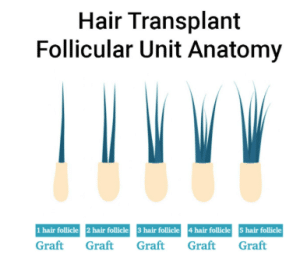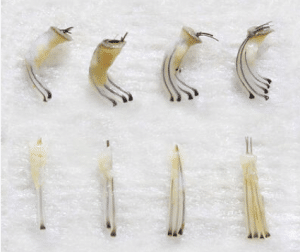How to Estimate the Number of Grafts You Need for a Hair Transplant Treatment
Hair loss can take a serious toll on your appearance and confidence. If you’re considering a hair transplant, you’re not alone, and thanks to advancements in techniques like DHI™ (Direct Hair Implantation), achieving natural, long-lasting results is now more effective than ever.
Before beginning your hair restoration journey, one of the most crucial questions to ask is: “How many grafts will I need?” Understanding your graft requirement is key to setting realistic expectations and planning a successful, personalized treatment.
In this blog, we will break down:
- What exactly a hair graft is
- The main factors that influence graft requirements
- How experts estimate the number of grafts you may need for natural-looking results
Whether you’re in the early stages of hair loss or looking to restore a fuller hairline, this guide will help you make informed decisions about your treatment plan.
What is a Hair Graft? Everything You Need to Know Before a Hair Transplant
If you’re considering a hair transplant, you’ve likely come across the term “hair graft.” But what exactly is a hair graft, and why is it so important for a successful hair restoration procedure?
Understanding Hair Grafts
A hair graft is a small piece of tissue containing one to four hair follicles, which are the root structures responsible for growing hair. During a hair transplant, these grafts are typically harvested from the donor area, usually the back or sides of the scalp, where hair tends to be more resistant to balding.
Each graft can hold multiple hairs, depending on your natural hair grouping. For example:
- Single follicle grafts are ideal for creating a soft, natural-looking hairline.
- Multiple follicle grafts (2–4 hairs) are often used to increase density in larger areas of hair loss.
Why Graft Quality and Placement Matter
The key to a natural-looking hair transplant lies in the proper handling and placement of these grafts. Skilled hair restoration surgeons carefully separate and implant the grafts based on their size and follicle count to mimic the natural growth pattern of your hair. This strategic approach helps:
- Achieve better coverage of thinning or balding areas
- Ensure a realistic hairline
- Maximize the survival rate of each graft
- Deliver long-lasting results

How the DHI Technique Improves Hair Graft Implantation
One of the most advanced techniques in hair restoration is Direct Hair Implantation (DHI™). Unlike traditional methods, DHI™ involves a precise and minimally invasive process where hair grafts are extracted and implanted using a specialized implanter tool.
Key benefits of DHI include:
- No cuts or stitches required
- Faster healing and reduced downtime
- Higher graft survival due to immediate implantation
- Natural angles and direction of hair growth for seamless results
Whether you’re experiencing early signs of hair thinning or advanced hair loss, understanding how hair grafts work, and how techniques like DHI™ optimize their placement, can help you make an informed decision.
A successful hair transplant doesn’t just depend on the number of grafts used. It’s the quality, handling, and strategic placement of those grafts that determine how natural and full your hair will look. If you’re looking for a long-term solution to hair loss, consult with a certified hair transplant specialist to see if DHI™ or another technique is right for you.
Direct Hair Implantation (DHITM) is an advanced and minimally invasive hair transplant technique designed to deliver natural-looking results with a quicker recovery time. Unlike traditional hair transplant methods, DHI™ eliminates the need for scalpels, stitches, or visible scarring. Let’s explore how this state-of-the-art procedure works, step by step.
Step 1: Graft Extraction – Precision at Every Follicle
Tool Used: Micromotor or manual punch (diameter: 0.6mm–1.0mm)
Area: Typically the donor area at the back of the scalp
Procedure:
- The donor area is shaved and numbed using local anesthesia to ensure patient comfort.
- Individual hair follicles (also known as grafts) are carefully extracted one by one using a micro punch tool.
- These grafts are sorted into groups, single, double, triple, or quadruple follicles, and preserved in a special solution that maintains their vitality and increases survival rate.
- This is a no-scalpel, no-stitches extraction process, ensuring a smooth and scar-free experience.
Step 2: Follicle Implantation – Natural and Precise Placement
Tool Used: Patented DHI™ Implanter
Procedure:
- Each extracted graft is carefully loaded into the DHI™ implanter.
- The surgeon implants the hair follicle directly into the scalp in a single motion, this means no need to pre-make recipient site incisions.
- The depth, direction, and angle of each hair are precisely controlled to mimic the natural hair growth pattern, resulting in a fuller and natural hairline.
How Many Grafts Do You Need for a Hair Transplant?
If you’re considering a hair transplant, one of the most common questions is: “How many grafts will I need?” The answer depends on several personal factors, and it’s rarely the same for everyone. Let’s break down the key elements that influence the number of grafts required and provide you with stage-by-stage estimates to help you better understand your unique hair restoration needs.
Key Factors That Determine Graft Requirements
Several important aspects come into play when calculating how many hair grafts are needed for a successful transplant:
- Extent of Hair Loss
The degree of hair loss is typically measured using the Norwood Scale for men and the Ludwig Scale for women. The higher the stage on the scale, the more grafts you’ll usually need to achieve natural-looking coverage.
- Size of the Balding Area
The larger the area that needs to be covered, the more grafts will be required. This is one of the most direct factors affecting the total graft count.
- Hair Characteristics
Hair type matters. Thicker, curlier, or coarser hair often gives better coverage than fine, straight hair. As a result, individuals with denser hair strands may need fewer grafts to achieve the same visual result.
- Donor Hair Density
The density and quality of hair in your donor area (typically the back and sides of your scalp) will influence how many grafts can be harvested safely. If you have a strong donor area, you have more flexibility in covering larger bald areas.
- Desired Outcome
Whether you’re aiming for a natural look or high-density coverage also impacts graft numbers. A conservative approach will require fewer grafts, while a dense restoration demands more.
- Surgeon’s Expertise
A skilled hair transplant surgeon can make a big difference. Experienced specialists know how to place grafts effectively, using fewer follicles for maximum aesthetic impact.
Together, these factors help your surgeon design a customized treatment plan that balances results, safety, and long-term satisfaction.

Graft Estimation by Hair Loss Stage (Norwood Scale)
Here’s a rough guide to how many grafts or hairs you might need, depending on your stage of hair loss, based on the Norwood Scale:
- Stage 1 & 2: These early stages often involve minimal hairline recession. If you’re looking to lower the hairline or add density, you may need 1,500 to 2,000 grafts, translating to about 3,500 to 4,500 hairs.
- Stage 3: Hair thinning is more pronounced in the frontal area and temples. Typically, around 3,500 to 4,500 hairs are required. If the crown area also needs coverage, the hair count will increase.
- Stage 4: This stage involves noticeable loss at both the front and crown. You may need 3,500 to 4,000 hairs for the front, and an additional 3,500 to 4,000 hairs for the crown.
- Stage 5 and Beyond: In more advanced stages, hair loss is extensive. Graft requirements can range from 5,000 to 12,000 hairs, depending on your donor area’s strength and your restoration goals.
Why Estimates Vary from Person to Person
These numbers are only estimates. Every individual’s hair texture, donor density, and goals are different. Someone with thick, curly hair might need fewer grafts to achieve full coverage than someone with fine, straight hair. Likewise, patients seeking just a hairline correction may only need a few hundred grafts, while those restoring both the front and crown might need thousands.
With the right strategy and surgeon, even a modest number of grafts can deliver impressive, natural-looking results. Before-and-after transformations often show how effective a carefully planned transplant can be, regardless of the hair loss stage.
How Many Hair Grafts Do You Need? A Surgeon’s Guide to Hair Transplant Planning
If you’re considering a hair transplant, one of the first questions you’re likely to ask is: How many hair grafts will I need? This isn’t something to guess, it’s a precise, medically guided process that varies from person to person.
In this guide, we’ll break down how expert surgeons determine the number of grafts you need, why it’s important, and how this affects your final results. Whether you’re in the early stages of hair loss or exploring options for advanced baldness, understanding graft calculation can help you make confident, informed decisions.
What Is a Hair Graft, and Why Does It Matter?
A hair graft is a small piece of scalp tissue containing 1–4 hair follicles. During a hair transplant, these grafts are moved from a donor area (usually the back or sides of your head) to the balding or thinning areas. The success of your transplant, how natural it looks, how full it appears, depends heavily on the accurate calculation and placement of these grafts.
How Do Surgeons Calculate the Number of Grafts You Need?
Calculating the number of grafts is a scientific process. At leading clinics, including those offering hair transplants in India, surgeons use a mix of digital tools and clinical expertise. Here’s how it works:
- Scalp Analysis
Using advanced diagnostic tools like the Unique Diagnosis Alopecia Test, surgeons analyze your scalp to assess:
- Degree of hair loss (using the Norwood scale)
- Scalp surface area
- Hair density and follicle count
- Donor area quality and density
- Density Planning
The ideal density for a natural look is usually between 30 to 50 grafts per square centimeter. Surgeons multiply the area needing coverage by the desired density to calculate the total number of grafts required.
- Hair Graft Calculator
A hair graft calculator may also be used to estimate how many grafts are needed based on your current stage of hair loss. However, this is only a starting point. A personalized consultation with a qualified doctor is essential to finalize your treatment plan.
Can the Number of Grafts Be Adjusted?
Yes, graft numbers are flexible. Your surgeon may adjust the count based on:
- Desired hairline or density
- Availability of donor hair
- Budget considerations
- Long-term hair loss patterns
Some patients may choose a phased approach, focusing on the front hairline first and covering the crown in a second session. A good surgeon will always preserve some donor hair for future treatments, ensuring long-term results.
Why Graft Planning Is Crucial for Long-Term Success
Overharvesting the donor area or placing too many grafts in one session can lead to unnatural results. A well-thought-out plan ensures:
- Natural hairline design
- High graft survival rate
- Long-lasting coverage
- Room for future procedures, if needed
Clinics that specialize in personalized hair loss diagnosis, like DHI India, prioritize precision to deliver natural, dense, and sustainable results.
Why Choose DHI™ for Your Hair Transplant?
DHI™ is a global leader in hair restoration, offering the patented DHI™ technique, a minimally invasive, safe, and natural-looking transplant method that sets a new standard in hair loss treatment.
Here’s what sets DHI™ apart:
Trusted Global Brand
- Over 5,00,000 satisfied clients across 75 clinics in 45+ countries
- Recognized with awards including IMRB’s #1 in Customer Satisfaction and the Quantic Customer Excellence Award
Advanced Technology & Safety
- One-step implantation ensures minimal graft handling and a 90%+ graft survival rate
- All procedures follow the UK Care Quality Commission and ISO standards
- Tools and instruments are sterile and single-use
Expert Doctors, Not Technicians
- Every DHI™ procedure is performed from start to finish only by trained doctors
- Doctors are certified by the London Hair Restoration Academy
Natural, Painless Results
- No stitches, scars, or downtime
- Natural results that blend seamlessly with your existing hair
- Known as the “Lunch Hour Transplant” by Daily Mail UK
Full Range of Solutions
DHI™ offers treatments for all stages of hair loss, including:
- PRP/GFC and Activa Regenera for early-stage alopecia
- Cosmetic hair patches for advanced stages
- Hair loss nutraceuticals with the highest-grade active ingredients
7 Essential Questions to Ask Before Choosing a Hair Transplant Clinic
Before committing, ask your clinic the following:
- Who will perform the procedure?
Ensure it’s a certified doctor, not a technician. - Is the doctor properly trained and accredited?
Look for credentials from reputable institutions and written SOPs. - What’s the clinic’s track record?
Experience matters. Look for clinics with years of consistent results and verifiable reviews. - How is quality monitored?
Ask about graft survival rates, tools used, and quality control protocols. - Are there strict safety standards?
Visit the facility. Confirm cleanliness, sterilization, and written safety protocols. - Was a proper alopecia diagnosis done?
Avoid one-size-fits-all solutions. A personalized diagnosis ensures effective treatment. - Is low cost worth the compromise?
Cheaper options may reuse tools, skip safety steps, or outsource to unqualified staff. Invest in quality for lifelong results.
Knowing how many hair grafts you need is only the beginning of your hair restoration journey. The real difference comes from accurate planning, skilled execution, and ongoing support.
If you’re looking for a trusted partner for your hair transplant, consider DHI™, a brand with over 55 years of innovation, safety, and results in the world of hair restoration.
Whether you’re just starting your research or ready to take the next step, DHI™ experts are here to guide you with personalized advice, accurate graft planning, and natural results.






